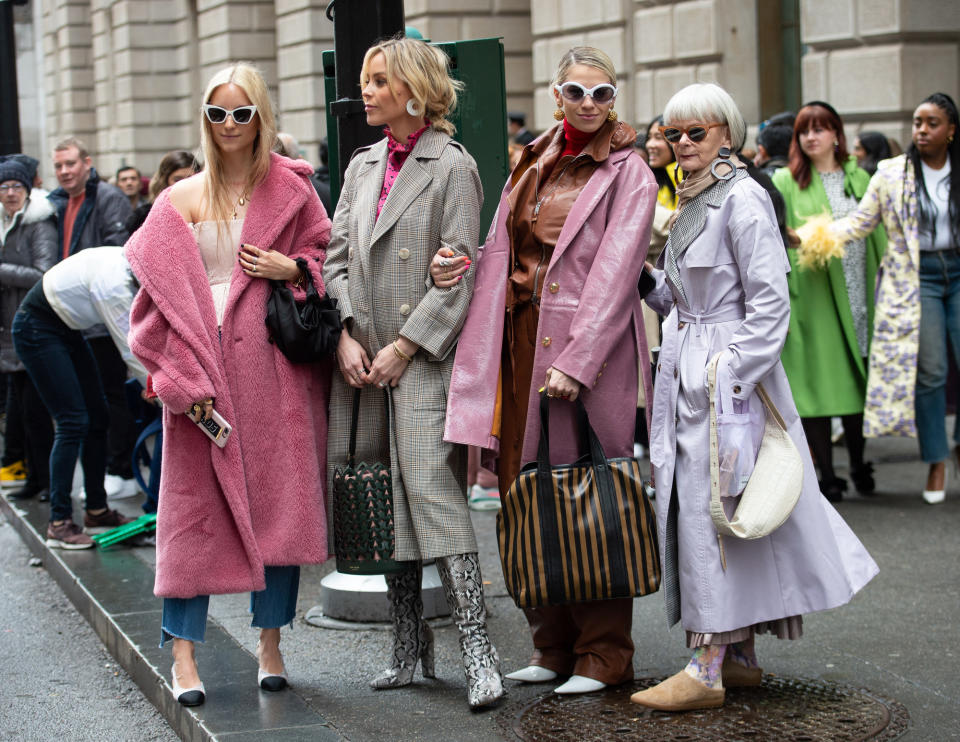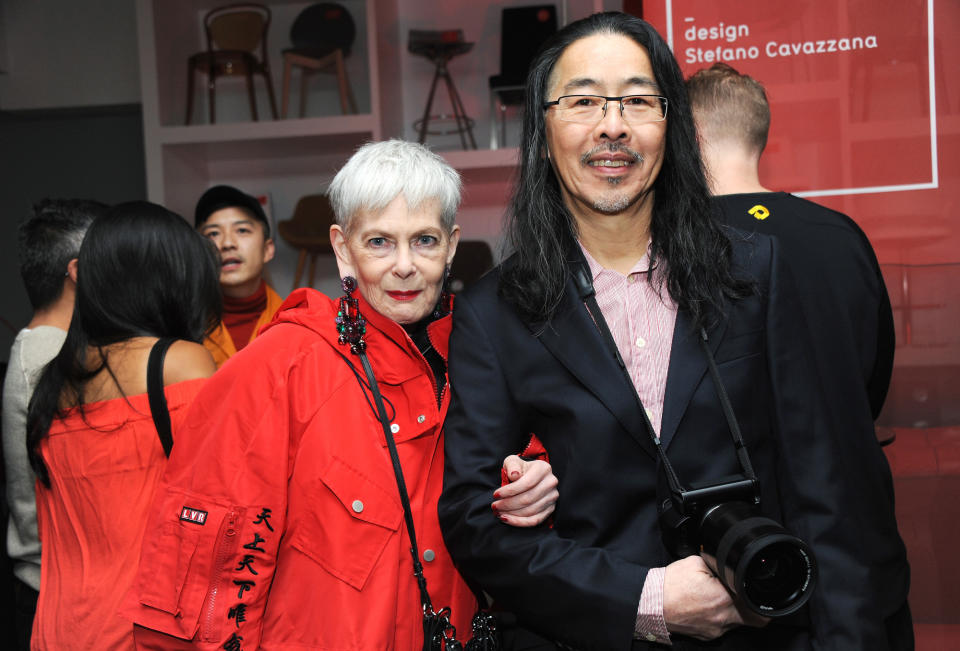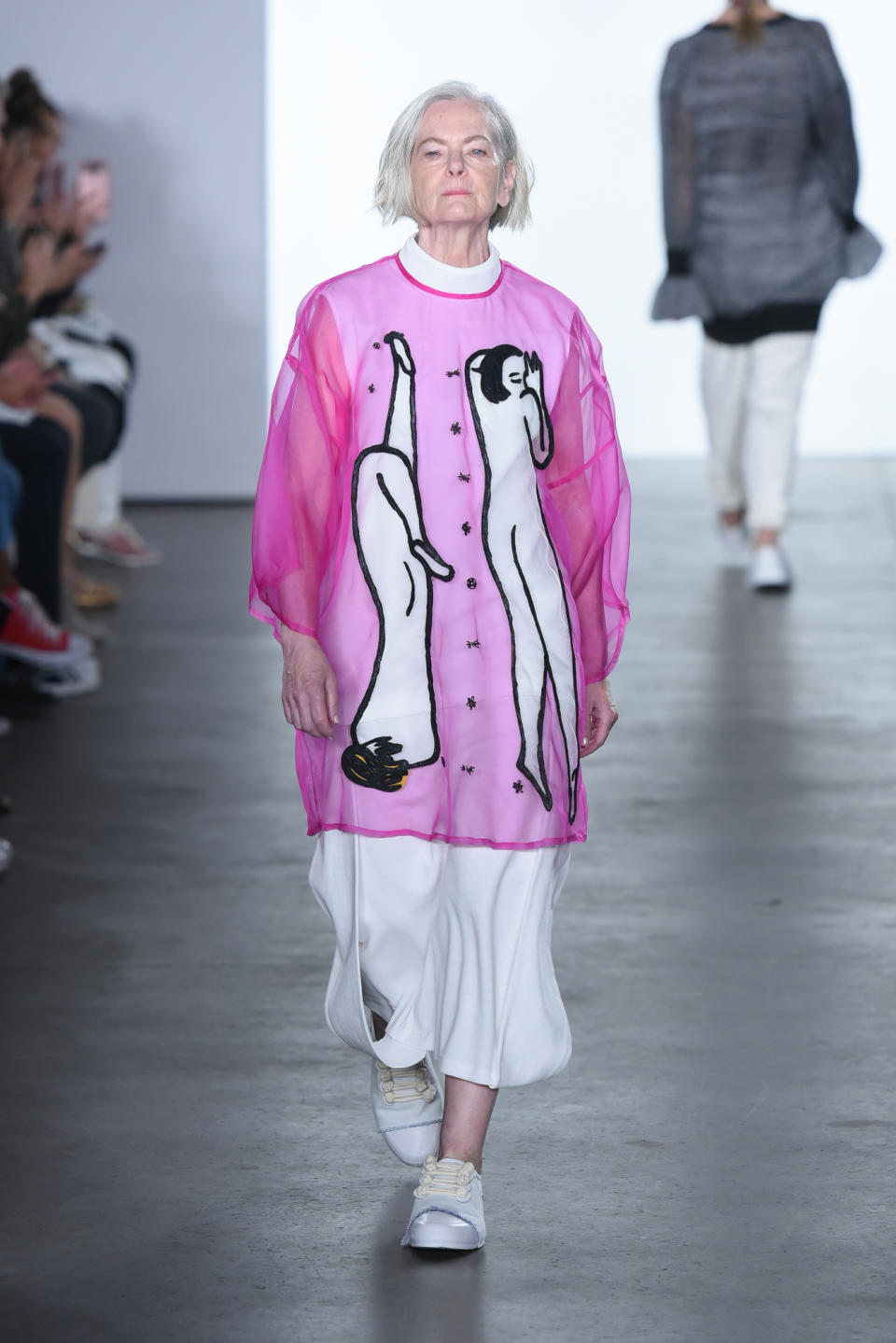Why Fashion and Beauty Influencer Lyn Slater Walked Away from a Lucrative Instagram Career

At the height of her status as an Instagram influencer, Lyn Slater, a 60-something-year-old professor-cum-fashion blogger, was putting up multiple branded posts a day (La Prairie, Burberry, Dior, Brooklinen, GoDaddy, Visa, Bally) for her more than 700,000 Instagram followers, fielding unceasing invites to fashion and beauty events, and banking the retirement nest egg she did not have the means to acquire while earning advanced degrees and toiling in academia. And she was miserable.
“I really lost my grip. I just became this disembodied, disconnected digital creature who I was starting not to like,” says Slater during a recent Zoom interview from her home in Peekskill, N.Y., a formerly down-at-the-heel industrial town that has been reinvented as a Hudson Valley refuge for creative exiles from New York City.
More from WWD
Celebrities Front Row at Valentino Fall 2024 Fashion Show: It's All Love
Huda Kattan Is Back as CEO of Huda Beauty, and She's Redesigning Her Brand
Slater, now 70, and her partner Calvin Lom, 66, a retired cyclotron engineer and the photographer of many of her Instagram photos, bought this house during the pandemic, after Slater realized that being a so-called influencer was a downward spiral of self-erasure. Moving here meant she could be closer to her mother, who died on Christmas morning in 2021, and her grandchildren. On this day, Slater sits in front of a mint-green wall in her home office/studio, which will be recognizable to her 769,000 Instagram followers as the backdrop for many of her now far less frequent posts.
In her new book, “How to Be Old: Lessons on Living Boldly From the Accidental Icon” (to be published March 12 by Plume, an imprint of Penguin Random House), Slater details her improbable journey from college professor to sought-after style influencer when she was in her 60s, the burnout that followed, and how she found her way out of it by embracing her age and reconnecting with her priorities. Part memoir, part self-help tome, “How to Be Old” is a reinvention story, a cautionary tale about the emptiness of life lived online, a paean to sustainable living and a personal narrative about what gives life meaning. It’s Slater’s first non-academic book, and one she struggled to birth as she became alienated from her true self on the consumerist hamster wheel of influencer stardom.

“I was trained as a clinician to always be critically reflective,” she explains. “So I knew I was becoming unhappy. I felt so uncreative. And of course, what begins to happen is the brands start sending you briefs, they’re showing you photos of what they want the photo to look like, they’re telling you what to put in captions. And if they don’t like how you took the picture, they send it back and say you have to take it again. And every ounce of your creativity is just getting drained away.”
It was Slater’s blog, Accidental Icon, that fueled her Instagram rise. She launched it in 2014 — designing it herself on Squarespace — at the suggestion of fellow students in a continuing education course at Fashion Institute of Technology. It began as an outlet for Slater’s creativity, and a showcase for her impeccable style. It was a form of expression that her job as a professor of social work (with a focus on child welfare), did not afford her. She wrote insightful and tender love letters to her favorite outfits — a black Yohji Yamamoto suit she picked up at a Brooklyn consignment shop, her Comme des Garçons finds from Rei Kawakubo and Adrian Joffe’s Dover Street Market — and engaged in a dialogue with like-minded followers about clothes in the service of constructing identity and facilitating self-exploration.
In the beginning, she used her status as a blogger to secure press passes to market shows, where she met emerging designers and deepened her education of the fashion business. The blog became a must-read for a clutch of young designers, as well as the fashion devoted who would show up at the shows in their most eclectic finery. At first Instagram was a means to promote her blog and commune with like-minded creatives. But the emergence of influencer culture supercharged the consumerist imperative. Two years into Accidental Icon, Slater, with her signature silver bob and dark sunglasses, was beginning to amass a significant number of followers. And perhaps because she was so relentlessly positive and responsive (in the beginning she sent each new follower a rose emoji), she did not elicit a significant amount of negative or abusive comments.
An early turning point came thanks in part to popular Chinese influencer Gogoboi, who wrote an article suggesting that she “could be a model for modern Chinese women,” Slater writes in her book, causing her to go viral on Weibo, and garnering her hundreds of thousands of new followers. Media profiles followed and then in late 2016, she answered a blind casting call for an eyewear campaign. It turned out to be for Valentino Glamgloss eyewear, conceived by creative director Pierpaolo Piccioli, and shot by Terry Richardson (right before the famed photographer was essentially cast out of the industry amid repeated accusations of exploitation and sexual abuse of models).
Slater was still naïve to the lucrative financial standards of luxury campaigns, and she accepted a payment of $1,550 from Valentino. But when the campaign launched in early 2017, as the industry was in the throes of another glancing inclusion foray (the previous year, French luxury brand Céline signed the writer Joan Didion, then 80), it catapulted her career to another level. As if overnight, Slater had become the new face of the industry’s beauty-at-any-age trend.

“The transgressive part of me being in a Valentino ad was that I was a nobody, in a sense,” Slater says. “I was just as ordinary professor at the time, and yet I was being put in that ad. That was the first time you saw an ordinary older woman in a big fashion brand advertisement. That opened the door.”
What began as an extension of Slater’s creative outlet, her Instagram feed, quickly became her bread-and-butter. In 2019, after 24 years as a professor at Fordham University, she retired so she could devote her full attention to being an influencer. By then she had a literary agent and modeling agent (at Elite Models); she was traveling the world (Paris, London, Tokyo and Shanghai), and making a lucrative living as a person on social media who tells their followers what to buy. At the height of her influencer status, she was posting several times a week; her Instagram is festooned with artfully posed portraits of Slater with a veritable onslaught of beauty products, luxury clothes, home goods and wine. (She doesn’t drink, but there are several partnership posts of Slater with friends and relatives toasting with La Marca Prosecco.)
“The early years, before I became really well known, were amazing. I was meeting all these designers and talking to them about their work and learning about how clothes are made,” she says.
The opportunities that came with Instagram fame proved irresistible. Her first trip to Paris was a 48-hour jaunt, when she was 66 years old, at the invitation of Maison Martin Margiela; Slater was contracted to promote the new Margiela perfume Mutiny.
“I was getting to travel in a way that, in my prior life, I could never have afforded; first class, five-star hotels. I still had my social work life where I was consulting and going to conferences, and flying economy class,” she laughs. “Accidental Icon was sort of a performance, it was a character that I invented to travel in a different world than the one I was living in. But it really did change when I made that transition from blogger to influencer.”
From the beginning, Slater was uncomfortable with the ageist way media outlets portrayed her as they were documenting her late-in-life second career as a social media personality and fashion model; the first and last question from every interviewer, she says, was always about her age. On her blog, she was in control of her narrative. On social media, she began to feel compartmentalized and tokenized.
“Once you put yourself out on TikTok or Instagram, society is going to start hijacking your story. I’m put in these articles with a bunch of other people who have gray hair on Instagram and I’m being called a senior influencer or an Insta-Gramma,” she says, making air quotes with her fingers, “even though I had more followers and higher monetization than many young people. It was like, ‘OK, we’re going to let you be here, but we’re going to put you in a senior community.’”

Slater chafes at the lazy stereotyping and ageist characterizations of old people as either demented and moldering away in assisted living facilities or defying age (which is admittedly impossible) with a bottomless menu of expensive beauty products and cosmetic surgery. Now, she observes, the big luxury conglomerates have for the most part reverted to unattainable standards of beauty. And inclusion is, as it was, happening on the emerging brand level, rather than at established houses with billions of dollars in annual sales. (She singles out Hillary Taymour and Batsheva Hay’s eponymous labels as among the few that consistently feature nonstandard models at their runway shows and in their campaigns.)
“More and more, the vision of older women in fashion are celebrities and supermodels who might be 50, but they’re still supermodels,” Slater says. “When I transitioned into an influencer on Instagram is when everything started to go downhill for me.”
She points out that the successful older influencers, including Grece Ghanem, are all “thin, white, privileged, looking young. That is how we want to represent older women now; sort of ageless, fit, independent. And that is not the reality of older age.”
Slater became keenly aware of the dehumanizing effect of selling herself in the service of selling products. She writes that the unrelenting pressure to constantly post, to always be out at events, began to feel overwhelming. Her small New York City apartment was stuffed with rolling racks jammed with luxury clothes and endless boxes of expensive beauty products. “At some point,” she writes in her book, “I stopped being a unique person and became a brand. I forgot I had a body. I colluded in my own disappearing act by becoming an ‘influencer’ in the capitalist sense of the word, not an influencer of culture change as I had originally started out to be.”
She writes of feeling a deep sense of shame for succumbing to the illusory trappings of fame and consumerism.
“I feel ashamed as I remember the emerging designers at the market shows who cared so much about sustainability, who I wrote about because I believed in sustainability too. I remember how when I first began this project, both in my life and in the photos I took for my blog, all I ever wore was vintage or recycled clothing, and now I am wearing only new clothes. Clothes that, because they’re not special to me, will probably be thrown away.”
Her epiphany came with the pandemic.
“That made everything stop,” she says. There were still a smattering of campaigns, but she had “huge amounts of free time.”

She started to write again; she began mini blogging on Instagram. She moved out of New York City, her home since the mid-’90s, after her divorce. And when the pandemic lifted and the fashion industry returned to in-person shows, and brands began to once again pitch her on paid partnerships, she demurred.
“I said to my agent, ‘I love you. Thank you for everything you’ve done. But I’m done,’” she says.
Instead, she spent her time caring for her mother during the remaining year of her life, and being a hands-on grandmother to two grandchildren. She started to write her book. And she donated all of those beauty products to a homeless shelter, dutifully recycling all of the packaging.
In December 2022, she began writing on Substack. Last January, she launched a monthly column in her local paper, the Peekskill Herald, about “how to be old where you live,” she says. (A tip from her first column: “When renovating the house we bought here in Peekskill, being realistic meant giving up my dream of a claw-foot bathtub in favor of a walk-in shower.”) Her book tour will include panel discussions with fellow writers including Christine Platt, Elizabeth White, Chloé Cooper Jones and Sari Botton.
“My life is very, very different than those four years where I was this public figure flaunting myself, traveling all over the world,” she says. “Being in conversation with other writers, that part is really exciting. What’s not exciting is having to make a style TikTok for People magazine.”
The book has brought her back into the world anew. But she would like the conversation to be different this time.
Being an influencer, she says, “just feels so unimportant, given the state of the world now. It’s really kind of scary. We’re already seeing the impact of [social media], the depression, the mental health issues, the loneliness, sexual exploitation. And the thing I can’t get my head around is we know all this, but we do nothing about it. It’s like we’re all in a trance. People still seem to think that being an influencer is a glamorous, fabulous, wonderful thing. But I have been meeting with young influencers who have quit because of the serious impact on their mental health. And so it’s been very interesting having conversations about how this book should be positioned. I’ve been of the mind that it really needs to be about the second part of the story, the second reinvention, because I think people are in a serious mood now. How could you not be?”
Slater certainly is.
“I follow a lot of young women writers who are really asking very hard questions about their own lives,” she says, “about youth and beauty standards, about motherhood, about divorce, about not wanting children. They’re really taking on these issues. And I think that they need to ask us the hard questions about being older.”
Losing her mother, as well as friends, has foregrounded death for Slater. She’s not consumed by it. But, she says, “understanding that you will die brings you this deep motivation and commitment to living every moment of your life as fully as you can and not wasting another second of time.”
And that is how to be at any age.
Best of WWD

